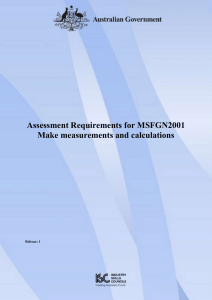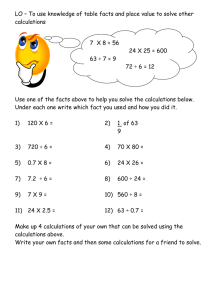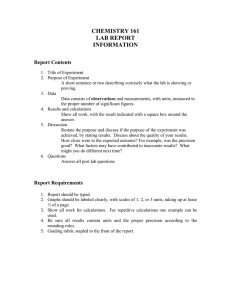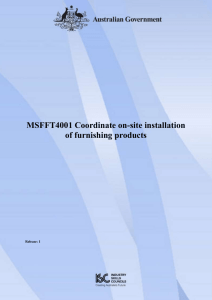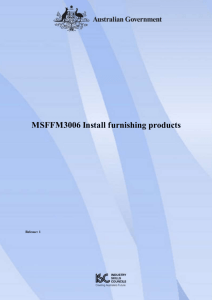MSFGN2001 Make measurements and calculations
advertisement
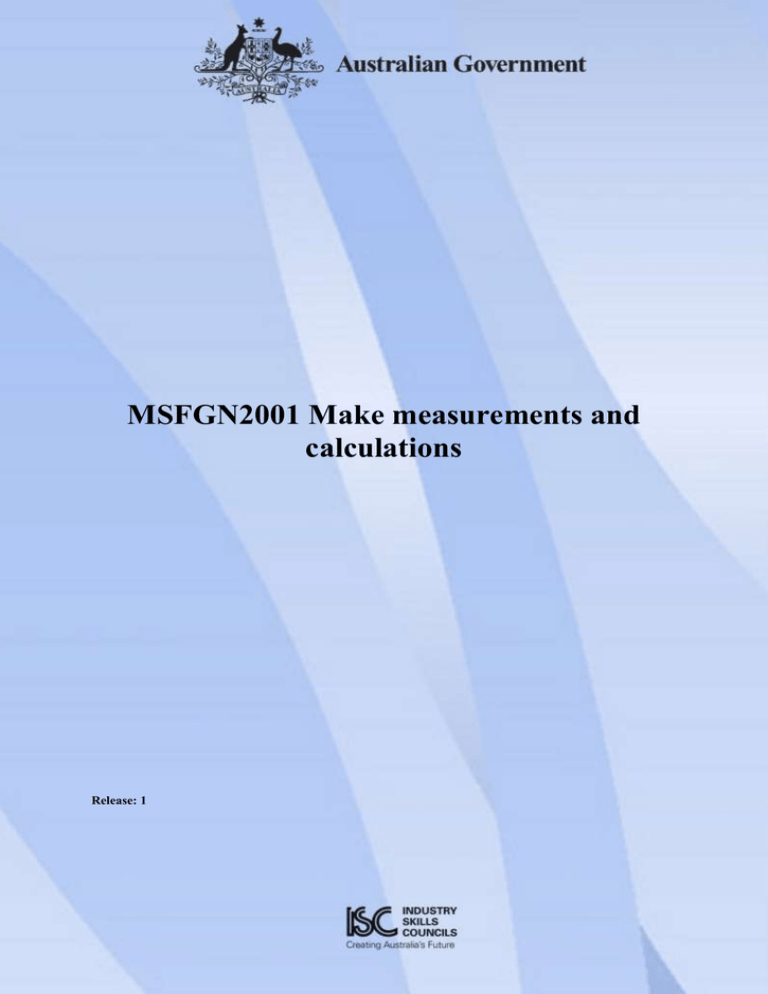
MSFGN2001 Make measurements and calculations Release: 1 MSFGN2001 Make measurements and calculations Date this document was generated: 12 July 2016 MSFGN2001 Make measurements and calculations Modification History Release 1 - New unit of competency Application This unit of competency covers taking measurements and making calculations for furnishing tasks undertaken in a variety of sites and locations. No licensing, legislative or certification requirements apply to this unit at the time of publication. Pre-requisite Unit Competency Field Unit Sector Generic Elements and Performance Criteria Elements describe the essential outcomes. Performance criteria describe the performance needed to demonstrate achievement of the element. 1 1.1 Appropriate measuring equipment for the task is selected 1.2 Measuring units to be used, and the detail required, is identified from work documents 1.3 Measuring equipment condition and calibration is checked to confirm it is fit for purpose 2.1 Range of results that may be obtained is estimated 2.2 Relevant external factors affecting measurement accuracy are identified and taken account of 2.3 Measurements are performed using appropriate techniques 2.4 Measurements are compared against the range of expected 2 Identify appropriate measurements and equipment Perform measurements Approved © Commonwealth of Australia, 2016 Page 2 of 5 Manufacturing Skills Australia MSFGN2001 Make measurements and calculations Date this document was generated: 12 July 2016 results 2.5 3 4 5 Numerical information is checked for accuracy and correctness Perform calculations 3.1 Measurement data to be used for calculations is identified from work instructions 3.2 Appropriate calculation methods and techniques and tools are determined 3.3 Calculations are carried out and results checked and confirmed as accurate 3.4 Material quantities are estimated using relevant standard packaging units Record measurements and calculations as required 4.1 Measuring and calculation results are accurately recorded in the appropriate format 4.2 Results are recorded to the required level of detail Recognise routine and non-routine problems 5.1 Known faults that can occur during measurement activity are recognised 5.2 Necessary action on causes of routine faults is identified and taken 5.3 Any problems are logged as required 5.4 Non-routine problems are identified and reported to designated person Foundation Skills Foundation skills essential to performance are explicit in the performance criteria of this unit of competency. Detail on appropriate performance levels for each furnishing unit of competency in reading, writing, oral communication and numeracy utilising the Australian Core Skills Framework (ACSF) are provided in the Furnishing Training Package Implementation Guide. Approved © Commonwealth of Australia, 2016 Page 3 of 5 Manufacturing Skills Australia MSFGN2001 Make measurements and calculations Date this document was generated: 12 July 2016 Range of Conditions Specifies different work environments and conditions that may affect performance. Essential operating conditions that may be present (depending on the work situation, needs of the candidate, accessibility of the item, and local industry and regional contexts) are included. Range is restricted to essential operating conditions and any other variables essential to the work environment. Unit context includes: Measuring and calculating equipment include: Measurements include: Calculations include: Materials include: Approved © Commonwealth of Australia, 2016 Work health and safety (WHS) requirements, including legislation, building codes, material safety management systems, hazardous substances and dangerous goods codes, and local safe operating procedures work is carried out in accordance with legislative obligations, environmental legislation, relevant health regulations, manual handling procedures and organisation insurance requirements rules tapes measures squares callipers weighing scales calculators computers laser or equivalent technology quantities of materials size, weight and volume of materials dimensions of products and components size and volumes of installation spaces plans for cutting, drilling and shaping materials placement of templates and production sizing use of analogue, dial, scale and digital readouts area perimeter volume mass scales and ratios (ingredients/elements and triangulation) addition subtraction multiplication division percentages staff and other business costs furniture (timber and composites) resilient, woven and timber flooring materials Page 4 of 5 Manufacturing Skills Australia MSFGN2001 Make measurements and calculations Routine and non-routine problems include: Personal protective equipment includes: Information and procedures include: Date this document was generated: 12 July 2016 soft furnishing items liquids used in furnishing manufacture and installation glass components (outputs of production processes) measuring instrument not fit for use (e.g. not within calibration) appropriate measuring device not available deviations from normal range of measurement readings effect of temperature and humidity on material properties uneven and irregular shaped surfaces that prescribed under legislation, regulations and enterprise policies and practices workplace procedures relating to the use of tools and equipment work instructions, including job sheets, cutting lists, plans, drawings and designs standard unit packaging of furnishing materials workplace procedures relating to reporting and communication manufacturer specifications and operational procedures work documents and logs are to include hard copy and computerised versions Unit Mapping Information No equivalent unit Links MSA Training Package Companion Volumes http://companion_volumes.vetnet.education.gov.au/Pages/TrainingPackage.aspx?pid=35 Approved © Commonwealth of Australia, 2016 Page 5 of 5 Manufacturing Skills Australia
